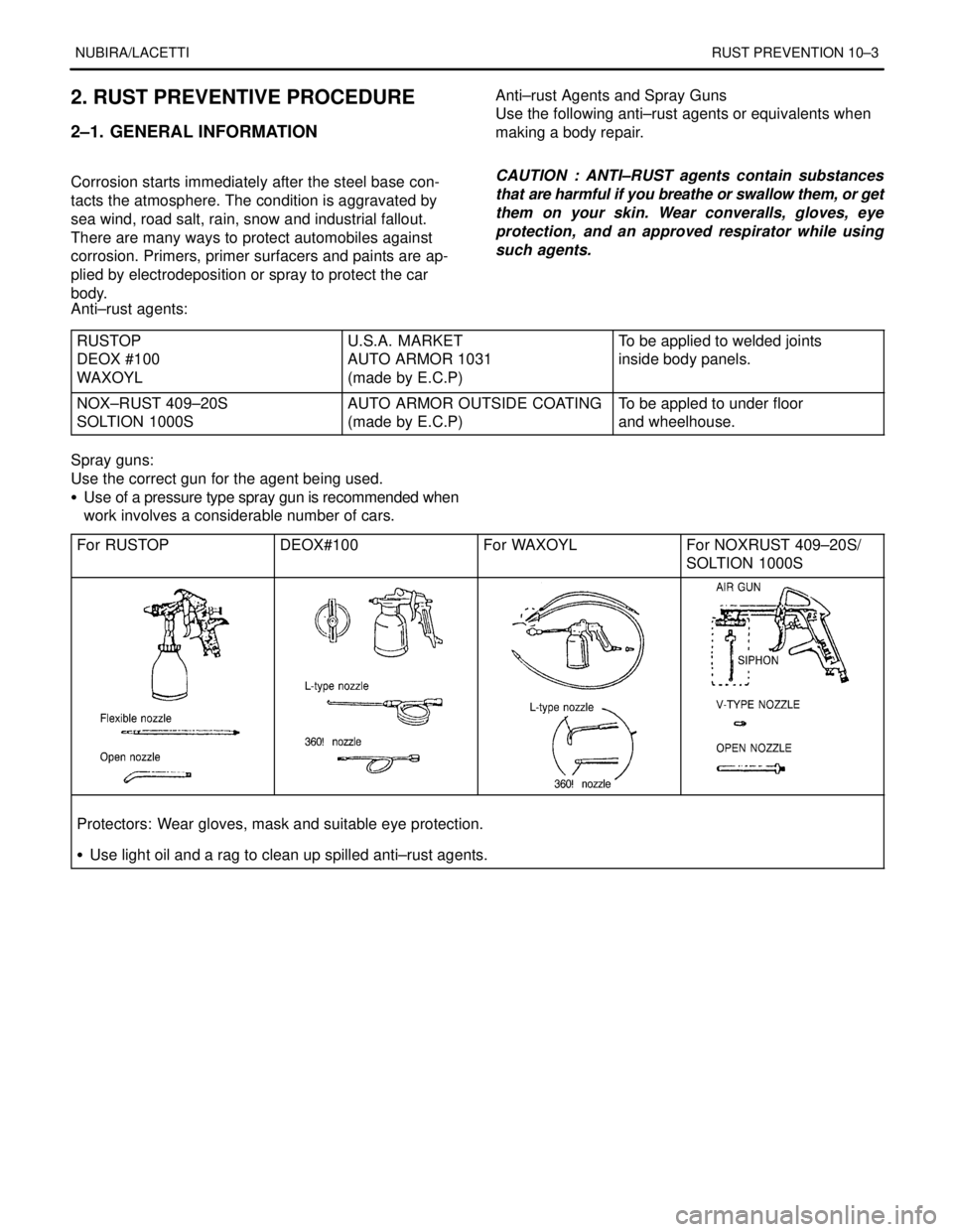2004 DAEWOO LACETTI recommended oil
[x] Cancel search: recommended oilPage 334 of 2643

1F – 88IENGINE CONTROLS
DAEWOO V–121 BL4
IGNITION SYSTEM CHECK (1.8L DOHC)
Circuit Description
The Electronic Ignition (EI) system uses a waste spark
method of spark distribution. In this type of EI system, the
Crankshaft Position (CKP) sensor is mounted to the oil
pump near a slotted wheel that is a part of the crankshaft
pulley. The CKP sensor sends reference pulses to the en-
gine control module (ECM). The ECM then triggers the EI
system ignition coil. Once the ECM triggers the EI system
ignition coil, both of the connected spark plugs fire at the
same time. One cylinder is on its compression stroke at
the same time that the other is on the exhaust stroke, re-
sulting in lower energy needed to fire the spark plug in the
cylinder on its exhaust stroke.
This leaves the remainder of the high voltage to be used
to fire the spark plug in the cylinder on its compression
stroke. Since the CKP sensor is in a fixed position, timing
adjustments are not possible or needed.
Test Description
The number(s) below refer to step(s) on the diagnostictable.
2. It is important to check for the presence of spark to
all of the cylinders to isolate the problem to either
EI system ignition coil inputs or outputs.
5. In checking the ECM outputs for the electronic
spark timing signal, it recommended to use an os-
cilloscope to view the varying voltage signals. In
measuring these outputs with a voltmeter, intermit-
tent errors may occur that cannot be seen by a volt-
meter.
6. After confirming ECM inputs for the electronic spark
timing to the EI system ignition coil are OK, it can
be determined that a faulty EI system ignition coil is
at fault.
11. After confirming proper CKP sensor inputs to the
ECM and no wiring problems present, it can be de-
termined that the ECM is at fault.
24. This step, along with step 25, checks for battery
voltage and a ground to the EI system ignition coil.
Page 965 of 2643

TIRES AND WHEELS 2E – 3
DAEWOO V–121 BL4
MAINTENANCE AND REPAIR
ON–VEHICLE SERVICE
WHEEL
Removal Procedure
1. Loosen the wheel bolts.
2. Raise and suitably support the vehicle.
3. Remove the wheel bolts.
Notice : Never use heat to loosen a tight wheel. It can
shorten the life of the wheel, the wheel nuts and the wheel
bearings. Excessive force, such as hammering the wheel
or tire, can also cause damage and is not recommended.
Slight tapping of the wheel sidewall with one’s hand or with
a rubber mallet is acceptable.
4. Remove the wheel.
Difficulty in removing the wheels from the vehicle can be
due to foreign material or to a tight fit between the wheel
centerhole and the hub or the rotor. These wheels can be
removed by
5. Retightening the wheel bolts on the affected wheel
and then loosening the wheel bolts by two turns.
6. Lowering the vehicle and rocking it from side to side
as hard as possible, using one or more person’s
body weight to loosen the wheel.
7. Raising the vehicle and removing the wheel.
CAUTION : Do not allow the penetrating oil to get on
the vertical surfaces between the wheel and the drum
(or rotor) because penetrating oil in this area could
cause the wheel to work loose as the vehicle is driven,
resulting in loss of control and an injury accident.
Penetrating oil is not effective in removing tight wheels. If
it is used, however, apply it sparingly and only to the
wheel’s centerhole area.
Installation Procedure
Notice : Before installing the wheels, remove any buildup
of corrosion on the wheel mounting surface and the brake
drum or the rotor mounting surface by scraping and brush-
ing them with a wire brush. Installing the wheels without
good metal–to–metal contact at the mounting surfaces
can cause the wheel nuts to loosen, which can later allow
a wheel to come off while the vehicle is moving. Wheel
bolts must be tightened in sequence and to the proper
torque to avoid bending the wheel, the brake drum or the
rotor.
1. Mount the wheel.
2. Install the wheel bolts in the sequence shown. Do
not tighten the wheel bolts.
3. Lower the vehicle.
Tighten
Tighten the wheel bolts to 100 NSm (74 lb–ft).
Page 2021 of 2643

MANUAL CONTROL HEATING, VENTILATION AND AIR CONDITIONING SYSTEM 7B – 19
DAEWOO V–121 BL4
MAINTENANCE AND REPAIR
ON–VEHICLE SERVICE
GENERAL A/C SYSTEM SERVICE PROCEDURES
O–RING REPLACEMENT
Important : Even though O–rings may look identical, it is
extremely important that only recommended service re-
placement air conditioning O–rings be used or excessive
leakage of refrigerant may occur.
Important : Always slip the O–ring onto the flange tube to
ensure proper locating and sealing.
Install new Daewoo–approved service replacement air
conditioning (A/C) O–rings whenever a joint or a fitting is
disassembled, except when the O–rings are provided on
new components.
When replacing O–rings on an A/C component or a joint
connection, the fitting design should be identified to en-
sure installation of the correct air conditioning service re-
placement O–ring. Some joint connections and compo-
nents will implement a ”captured” O–ring design fitting that
uses a groove to retain the O–ring. Others do not have a
groove and use a ”non–captured” or ”standard” O–ring.
Assembly and tightening procedures are the same for
both designs, but the O–rings are different.
Notice : Before installation, verify that both O–rings and
fittings have not been nicked or deformed. Deformed or
nicked parts must be replaced. Failure to use the proper
service replacement parts and procedures may result in
excessive refrigerant leakage.
HANDLING REFRIGERANT
CAUTION : Always work in a well–ventilated area and
avoid breathing any refrigerant fumes. If you have dif-
ficulty with breathing, seek medical attention immedi-
ately. If refrigerant comes in contact with any part of
your body, flush the exposed area with water. If a rash
or pain develops, seek medical attention.
Air conditioning systems contain refrigerant. This is a
chemical mixture which requires special handling proce-
dures to avoid personal injury.
Always wear goggles and wrap a clean cloth around the
fittings, the valves and the connections when performing
work that involves opening the refrigerant system. Do not
weld or steam clean on or near any vehicle–installed air
conditioning lines or components.
All refrigerant drums are shipped with a heavy metal screw
cap. The purpose of the cap is to protect the valve and the
safety plug from damage. It is good practice to replace the
cap after each use of the drum.If it is necessary to transport or carry any container of re-
frigerant in a vehicle, do not carry it in the passenger
compartment.
HANDLING OF REFRIGERANT LINES
AND FITTINGS
Notice : Using too low or too high torque when tightening
a fitting can result in loose joints or deformed joint parts.
Both conditions can result in refrigerant leakage.
S Keep all metal tubing lines free of dents or kinks.
Any line restrictions will cause the loss of system
capacity.
S Never bend a flexible hose line to a radius of less
than four times the diameter of the hose.
S Never allow a flexible hose line to come within 65
mm (2–1/2 inches) of the exhaust manifold.
S Inspect flexible hose lines regularly for leaks or
brittleness.
S Replace flexible hose lines with new lines if you find
signs of deterioration or leaking.
S Discharge all refrigerant of the refrigeration system
before disconnecting any fitting in the refrigeration
system.
S Proceed very cautiously regardless of the gauge
readings.
CAUTION : Keep your face and your hands away from
the fitting so that you will not be injured if there hap-
pens to be liquid refrigerant in the line.
S Open the fittings very slowly.
S If you notice pressure when you loosen a fitting,
allow the pressure to bleed off as described under
”Discharging, Adding Oil, Evacuating, and Charging
Procedures for A/C System” in this section.
S Cap or tape any refrigerant line immediately after it
is opened. This will prevent the entrance of mois-
ture and dirt, which can cause internal compressor
wear or plugged lines in the condenser, the evapo-
rator core, the expansion valve, or the compressor
inlet screens.
Important : Use two proper wrenches to connect the O–
ring fittings.
S Back up the opposing fitting to prevent distortion of
the connecting lines or the components.
S Back up both the swagged fitting on the flexible
hose connections and the coupling to which it is
attached with two wrenches to prevent turning the
fitting and damaging the ground seat.
S Keep the O–rings and the seats in perfect condi-
tion. A burr or a piece of dirt may cause a refriger-
ant leak.
Page 2621 of 2643

NUBIRA/LACETTIRUST PREVENTION 10–3
2. RUST PREVENTIVE PROCEDURE
2–1. GENERAL INFORMATION
.
Corrosion starts immediately after the steel base con-
tacts the atmosphere. The condition is aggravated by
sea wind, road salt, rain, snow and industrial fallout.
There are many ways to protect automobiles against
corrosion. Primers, primer surfacers and paints are ap-
plied by electrodeposition or spray to protect the car
body.Anti–rust Agents and Spray Guns
Use the following anti–rust agents or equivalents when
making a body repair.
.
CAUTION : ANTI–RUST agents contain substances
that are harmful if you breathe or swallow them, or get
them on your skin. Wear converalls, gloves, eye
protection, and an approved respirator while using
such agents.
.
.
Anti–rust agents:
RUSTOP
DEOX #100
WAXOYL
U.S.A. MARKET
AUTO ARMOR 1031
(made by E.C.P)To be applied to welded joints
inside body panels.
NOX–RUST 409–20S
SOLTION 1000SAUTO ARMOR OUTSIDE COATING
(made by E.C.P)To be appled to under floor
and wheelhouse.
Spray guns:
Use the correct gun for the agent being used.
S Use of a pressure type spray gun is recommended when
work involves a considerable number of cars.
For RUSTOP
DEOX#100For WAXOYLFor NOXRUST 409–20S/
SOLTION 1000S
Protectors: Wear gloves, mask and suitable eye protection.
S Use light oil and a rag to clean up spilled anti–rust agents.